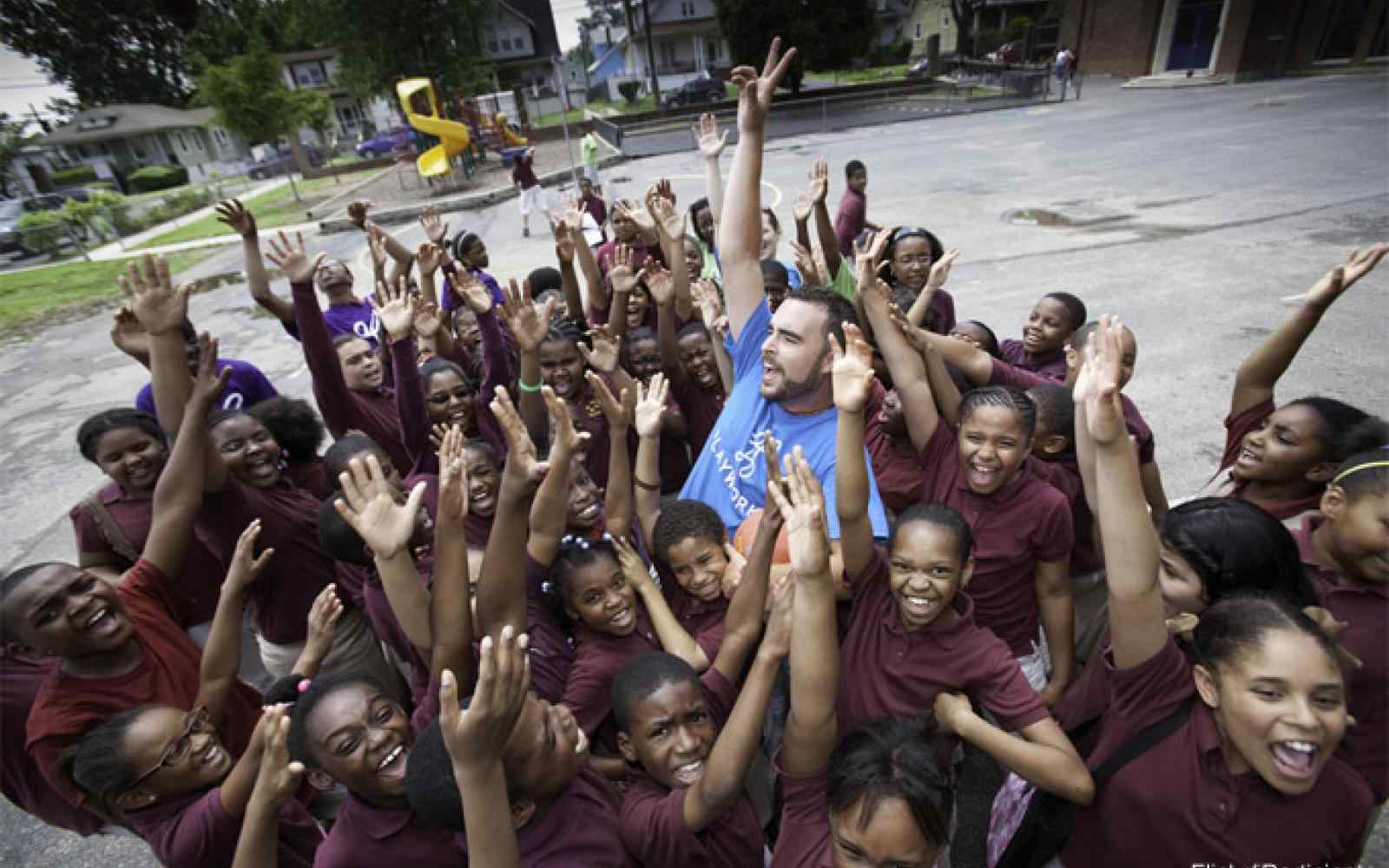The harsh sound of man’s voice sounded through a megaphone: “Okay, everybody line up now. Come on. Now, listen.”
The man was in an enclosure, behind a tall chain-link fence, shouting instructions to a crowd of young listeners half his height, bundled in jackets on a brisk December afternoon. Technically, this moment marked the start to “recess,” though it bore few of the standard accoutrements.
While there was brightly colored playground equipment in the background, it was fenced off and appeared virtually unused. Instead, the group stood in makeshift lines on an asphalt court.
Four boys managed to escape one line and were tussling off to the side, pulling and shoving one another in a way that suggested lion cubs at play, but that could instantly turn into a trip to the principal's office. The rest were shifting restlessly, talking and laughing over the din of the instructor's megaphone.
Mutiny loomed, and the teacher knew it. With growing exacerbation, he shouted instructions for an upcoming game of tag: “If you’re not sure who’s out, play rock-paper-scissors-shoot. Okay?”
No response, just a shuffle of feet and jackets. Had there been barbed wire atop the fence, it would have been easy to mistake this place for another kind of state institution.
My colleague and I stumbled on this scene quite by accident. We were struck by the harsh setting, strict regulation, and absence of play on this Brooklyn playground. We wondered what it would take to turn this situation around: to use recess to equip kids with critical social skills, improve focus and release energy, and to make play fun again. So we called in the experts.
Since 1996, Playworks—founded by Ashoka Fellow Jill Vialet—has set out to foster a renaissance of healthy, kid-focused play, and has recently expanded to include 16 schools across New York and Newark, serving more than 7,500 students. I described the prison-like playground scene with Playworks' Brooklyn program manager, LaQuin Lay to see how he might do things differently.
First, coach Quin approaches recess with the kind of intense diligence and preparation that the most careful and beloved teachers approach the classroom. He starts by mapping out the space and deciding what games will be best-suited to the group and place.
When kids head out to the playground, he uses chants, claps, and call-and-response (rather than a megaphone) to get everyone jazzed and on the same page. Next he introduces expectations and explains he’s there—“to have fun and to help them have fun”—all this before outlining the rules of the game and how they’ll transition into game mode itself.
Although it sounds like a lot of logistics, each moment of instruction is sprinkled with participatory questions and rituals, and each transition is actually play unto itself; if you have to walk from one area to another, it’s not just in a single-file line, it’s by walking with “swag,” or on one foot, or as if you’ve just stepped in a giant puddle of maple syrup.
Conflict resolution is also part of the program, and in this respect the megaphone instructor is not entirely off; rock, paper, scissors is taught and actively encouraged on Playworks playgrounds as a quick problem-solver. If you’re not sure who’s out or who’s next in line, just play—one, two, three, shoot!—and get on with it.
But it’s not enough to just tell kids to play it. “You’ve got to sell it,” says coach Quin, by helping kids realize that if they’re spending more time in conflict they’re spending less time in fun.
In all likelihood, the man with the megaphone was an overworked teacher who was already overwhelmed by an overcrowded classroom. The last thing on his mind may have been facilitating the kind of recess that teaches kids how to get along and take care of each other, while still playing the game with absolute enthusiasm.
But even if he can’t make it to a Playworks training, the bottom line remains the same: “If you’re not having fun, the kid’s not having fun,” says coach Quin.
Adeola Whitney, Playworks' New York/New Jersey executive director, would further suggest that he just put down the bullhorn and start a clapping game—to which the kids would respond “without ever having been taught, and with smiles on their faces.”
In short, the playground coach needs to feel and respond to young people’s desire to play and create in safe spaces. Kids pick up on a coach’s empathy-infused leadership, and begin treating each other with more respect, resolving problems on their own without any adult intervention.
But empathy is not just a trickle down from coach to kid, and then from kid to kid. “We’ve really won as an organization when the empathy is from the kids to the adults,” says Whitney.
On a recent visit to a Playworks school, Whitney (aka coach Ola) joined a classroom for a game of “switch,” a kind of standing musical chairs. The kids taught her the game and made sure that she understood all of the rules before proceeding.
When Whitney was “unsuccessful” in an early round—(the terms “out” and “lose” are never used)—and began to make her way to the back of the line, she was stopped suddenly by a young girl she’d never met. “Wait, coach Ola!” the girl shouted. “You didn’t give me a high five!”
Coach Ola gave her a high five, and the girl continued: “Good job! Nice try! So you’re not going to leave, right? You’re going to try again, right?” This girl had no idea that Whitney was the program’s executive director, nor was she trying to earn brownie points. She was simply playing the game and exercising a way of being in the world that she probably didn’t learn from a megaphone.
Learn more about Ashoka’s Empathy Initiative! Visit empathy.ashoka.org.
